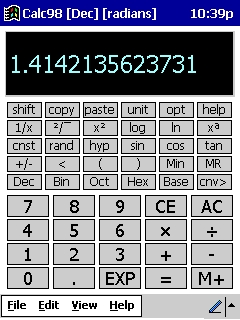Posters for Sale
Other Great Posters
Newspaper Article
Frequently Asked Questions
Calculator Lists
Calc98 for the PC
Desktop Calculators
Keyboard Trivia
Electronic Displays
Calculator Numbers
Collectors Guides
Other Links
Calculator Ring
The Calculator Home Page at calculator.org is a collection of resources related to calculators. Over two million PC and handheld device owners around the world are using Calc, our popular engineering, scientific and financial calculator for Windows. Feb 13, 2019 Calc98 is a Scientific, engineering, statistical and financial pocket calculator simulator program for the Microsoft Windows operating systems. It includes a comprehensive set of conversions, constants and physical property data, a built-in periodic table of the elements, number base conversions, vectors, matrices and complex numbers.
Curta...Posters
The Curta Poster
Owners Registry
Curta Registry
Curt Herzstark
Curt Herzstark
Curt Herzstark Interview
Curta Simulators
Olaf Veenstra's
Jan Meyer's
Pat Belford's
Tom Ferguson's
Technical
Curta Stats
Curta Variations
Curta Manual
Curta Date
Curta: Dimensions & Timing
Curta Disassembly
Curta Patents
Curta Tools
Curta Lubrication
Curta Repair Manuals
Jack's Curta Repair (US)
Hans' Curta Repair (Europe)
Romano's Curta Repair (Italy)
Collections
Curta: The Ayen Collection
Curta Pictures
Curta: Oldest
Curta Photos
Curta: Ray Traced
Curta Demos
Curta Demos
Curta: Cut & Special
Curta Prototypes
Curta Literature
Curta Ads
Curta Documents
Curta E-mails
Curta Literature
Articles
Curta Backup Article
Miniature Machine
Curta: Rally
Curta Articles
Curta Other
Curta Pins
Curta Museums & School
Curta: Media
- Books
- Stamp
- Audio
- Video
Curta Links
Curta Links
 Hewlett Packard...
Hewlett Packard... HPs Needed
HP Guide
Inside a HP-11
About a HP-95
HP Microcode
Made in USA
The HPs
HP Dates
HP Weights
30 Series Derivations
HP Publications
HP Articles
HP Codenames
Calculator For Windows 10
Texas Instruments...
TIs Needed
TI History
TI Accuracy
Newer TIs
TI Games
TI Articles

- After studying this section, you should be able to:
- Calculate basic problems involving Ohm’s Law
- • Use appropriate units and sub-units.
- • Use a scientific calculator with engineering notation.
Fig. 3.2.1 The Ohm’s Law Triangle
or (if you prefer) A ‘VIR’ Tree
Try a few calculations based on Ohms Law. For these you just need to use the three basic formulae described in Resistors & Circuits Module 3.1. Hopefully it´ll be a breeze. The important thing to remember is to use the correct version of the formula, and to get it the right way up (I = V/R is good but I = R/V is definitely NOT!). A simple visual aid to remembering the correct formula is the Ohms Law Triangle. Setting out V, I and R in this way is a reminder that V = IR (I multiplied by R), and I = V over (divide by) R and R = V over (divide by)I as shown in Fig 3.2.1.
Work out the answers using pencil and paper; if you don't write out the problem you WILL get mixed up half way and end up with the wrong answer. Of course the answer is not just a number, it will be a certain number of Ohms or Volts or Amperes, but wait, there is worse to come - those Ohms Volts or Amperes are very probably going to be kilohms or millivolts or microamperes, right? So you have to show that in your answer. No good just writing 56. Fifty six What? maybe 56Ω? Well if the real answer was 56KΩ you are still wrong, your answer is a thousand times too small!
But don't worry, to get you off on the right track you should download our 'Maths Tips' booklet, which shows you how to use your calculator with exponents and engineering notation to get the right answer every time.
Not got a scientific calculator? The 'Maths Tips' booklet explains what you need (and what you don't need so you don't spend your money unnecessarily). If you don't want to buy a scientific calculator, you can always pick up a free one on the net. PC users can try Calc98 from www.calculator.org/download.html. Whichever calculator you choose, read the instructions to become familiar with the working methods you should use as these do vary from calculator to calculator.
OK so now you have read these instructions, you are ready to start. Here is a way to set out a typical problem on paper so you (with practice) don't get confused.
First write down what is known from the question, and what is not known:

V = ? (V is the unknown quantity.)
I = 500mA (500 x 10-3Amperes) 500E-3 or 500EXP-3 when entering it into your calculator, depending on which model you use.
R = 50Ω
So given I and R the correct formula to find V can be found from the Ohm´s law triangle:
V= I x R so substituting the figures given in place of I and R gives:
V = 500E-3 x 50 (for E press the E, the EE or the EXP key and for - press the change sign +/− or (-) key, NOT the minus (-) key. So the calculator display should read:
V = 500E-3 x 50 and pressing = gives the answer 25
The correct answer is therefore 25V
Note: If you are using Calc98 for your calculations you need to set the View>Option>Display menu to Engineering (under the 'Decimal' choices).
Download Desktop Calculator Windows 10
It would be a good idea whilst you are in this menu to select 2 from the 'Decimals' drop down box to set the number of digits displayed after the decimal place. This will round your answer down to two decimal places, which is sufficiently accurate for most uses and stops you getting silly answers such as 4.66666666667µA, which would be too accurate measure in a practical situation!